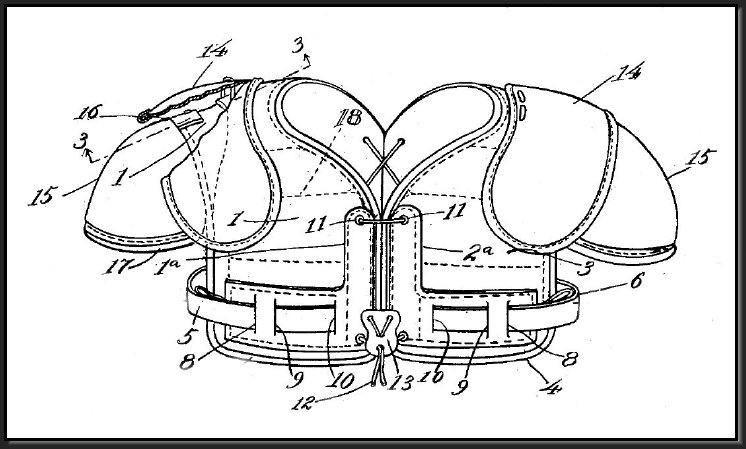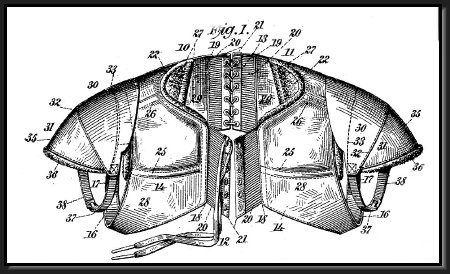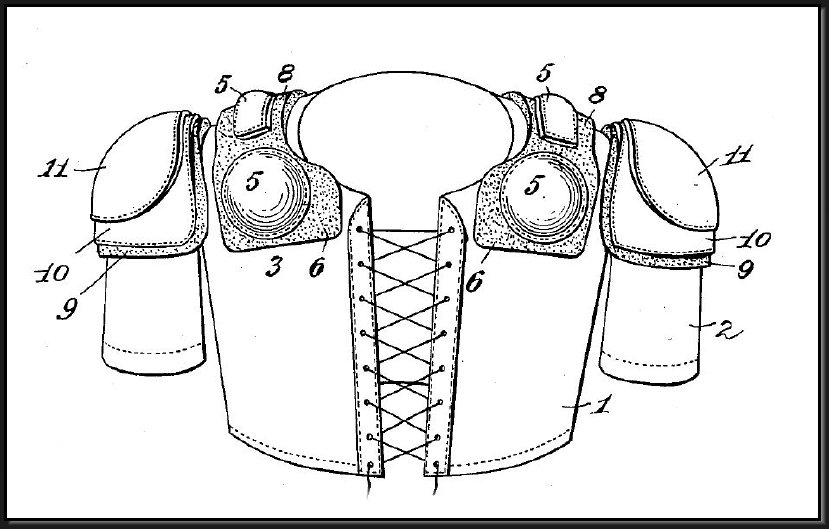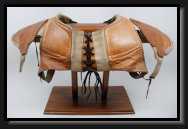Between 1917 and 1921, both Spalding and Reach sold a variety of combination shoulder and collarbone protectors that improved on Spalding's No. YF design. Reach's No. 22 and No. 33, and Spalding's No. GT and XF each featured a lace up leather collarbone pad similar to the No. LL, but with hinged, molded leather shoulder caps.


Questions or comments? Please email me at:
15 years after Abraham Schemel invented the Jacket for Foot-Ball Players, his design appeared in the 1921 Spalding catalog as the No. QS3. Listed as a "University model shoulder pad," the QS3 sold for $14.50 in 1923, which was more than twice the cost of the next most expensive model. Why did it take 15 years for Schemel's design to be mass-produced? One explanation could be the patent protection granted to Schemel for his design. Design patents grant protection of an invention for 14 years. During this time, no person or company can make or recreate the product without express permission from the patent holder. By 1921, Schemel's patent protection had expired and any company could freely manufacture pads based on his design.
Inspired by Schemel - The Spalding No. QS3

Perhaps the most significant advance in football shoulder pad evolution was the invention of the Football Protective Harness by Hugo Goldsmith and William A. Sonnett. Patented and assigned to the P. Goldsmith Sons Company in August, 1927, the protective harness incorporated several new enhancements that are still used in shoulder pads today. Goldsmith eliminated the underarm straps used on most combination pads that restricted range of motion. Elastic straps were employed at the chest and back to hold the pads firmly in place while also allowing the pads to be quickly slipped over the head and tightened.
Goldsmith's Football Protective Harness

Pad Advertisement, Spalding's Official Football Guide for 1919
Pad Advertisement, A.J. Reach Catalog, 1917
Pad Advertisement, Spalding's Official Football Guide for 1923
Patent Illustration, Jacket for Foot-Ball Players, Abraham Schemel, Submitted January 9, 1905
No. QS3, Spalding's Official Football Guide for 1923
It is the object of our invention to provide for a football player a shoulder and chest protective harness which will be readily adjustable, which will thoroughly protect the portions of the shoulder liable to injury and which will at the same time permit perfect freedom of arm movement which is required in the present "open" style game.
This combination of cap members which permits freedom of shoulder action and at the same time which furnishes complete protection for the shoulder, clavicle, arm socket, chest and collarbone, is the most important novel feature of our construction taken in combination with the lack of any straps binding under the arms.
According to the Goldsmith patent application:
Patent Illustration, Football Protective Harness, Goldsmith & Sonnett, Submitted May 2, 1925
Following the invention of the Football Protective Harness, hundreds of new improvements have been made to football shoulder pads to make them lighter, safer, and more comfortable. Plastics replaced leather pads in the 1940's and 1950's, and composites replaced plastics in the 2000's. The latest shoulder pad models employ pneumatic shock absorbers, quick release cords, and are manufactured to the exact measurements of each player. As the speed and style of the game of football continues to evolve, so too will the protective equipment worn by its combatants.







Patent Illustration, Foot Ball Protective Apparel, January 31, 1913.
Chris Hornung
May 10, 2015
May 10, 2015
Football Shoulder Pad Evolution

Updated: January 15, 2017
Page 3

